- Best for AI-powered forecasting and insights: Salesforce
- Best free alternative with core CRM features: HubSpot
- Best alternative for marketing and lead generation tools: Zoho CRM
- Best for managing projects with kanban boards: monday sales CRM
- Best for integrating with Google Workspace: Copper
Pipedrive is a customer relationship management tool that offers sales software, email software and over 400 potential integrations. Its CRM platform acts as a centralized sales hub for reps to collaborate, optimize their current processes and generate accurate forecasting. While the tool is praised for the user interface and customer support, there are similar providers that might align better with your business needs.
Top Pipedrive competitors and alternatives: Comparison table
Pipedrive is one of our top general CRM software, especially for its visual pipelines, easy-to-use building tools and key add-on upgrades. To demonstrate how Pipedrive might fare against other popular tools, we’ve highlighted some key features businesses consider when selecting CRM software. Our Pipedrive review dives deeper into the software’s most notable features, breaks down its pricing plans and summarizes its top pros and cons.
Otherwise, some stand-out CRM features we’ve called out to compare the alternatives include AI-powered tools, how intuitive their pipeline and deal management are, what type of integrations are offered and lastly, what advanced reporting tools can be found within the platform.
| Software | AI-powered tools | Pipeline management | Native and third-party integrations | Advanced reporting features | Pricing* |
|---|---|---|---|---|---|
| Pipedrive | Yes | Yes | Third-party only | Limited | $14 per user per month |
| Salesforce | Yes | Yes | Both | Yes | $25 per user per month |
| HubSpot | Yes | Yes | Both | Yes | Free starting price |
| Zoho CRM | Yes | Yes | Both | Limited | Free starting price |
| Monday Sales CRM | Limited | Yes | Third-party only | Yes | $12 per user per month |
| Copper | Limited | Yes | Third-party only | Yes | $23 per user per month |
*Price when billed annually.
Salesforce: Best for AI-powered forecasting and insights
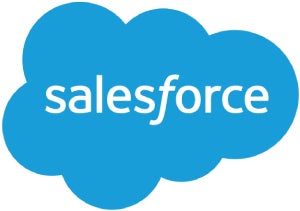
Salesforce offers advanced AI tools for any stage of a sales process, from buyer engagement, team collaboration, sales programs, analytics to CPQ and billing. Users can run, update and manage forecasts with live rollups of real-time visual signals. Reps have access to historical trends as well as AI predictions. After running opportunity health signals, reps can be guided by AI deal insights to drive focus on the right actions to move deals forward.
Pricing
- Starter Suite: $25 per user per month, billed annually. Users get account, contact, lead and opportunity management, as well as the mobile app, email integration and more.
- Professional: $80 per user per month, billed annually. The Professional plan includes all that’s found in Starter Suite plus Sales Cloud, full offline functionality and more.
- Enterprise: $165 per user per month, billed annually. This tier offers opportunity scoring and deal insights, plus data synchronization and harmonization.
- Unlimited: $330 per user per month, billed annually. The Unlimited tier includes all mentioned features above, plus Developer Pro sandbox, lead scoring and five Campaign Influence campaigns per opportunity.
- Einstein 1 Sales: $500 per user per month, billed annually. This tier includes all Salesforce CRM features like collaboration tools, knowledge shares and Slack and more.
Features
- Revenue and performance insights: Identify and minimize pipeline risks with improved forecast accuracy around rep activity and ongoing deals.
- Sales cadences: Give reps detailed instructions on how to prospect new leads, including when and how to complete email, phone and social touches.
- Buyer assistant: Use AI-powered webforms to communicate with potential leads online and connect buyers with the most relevant product information.
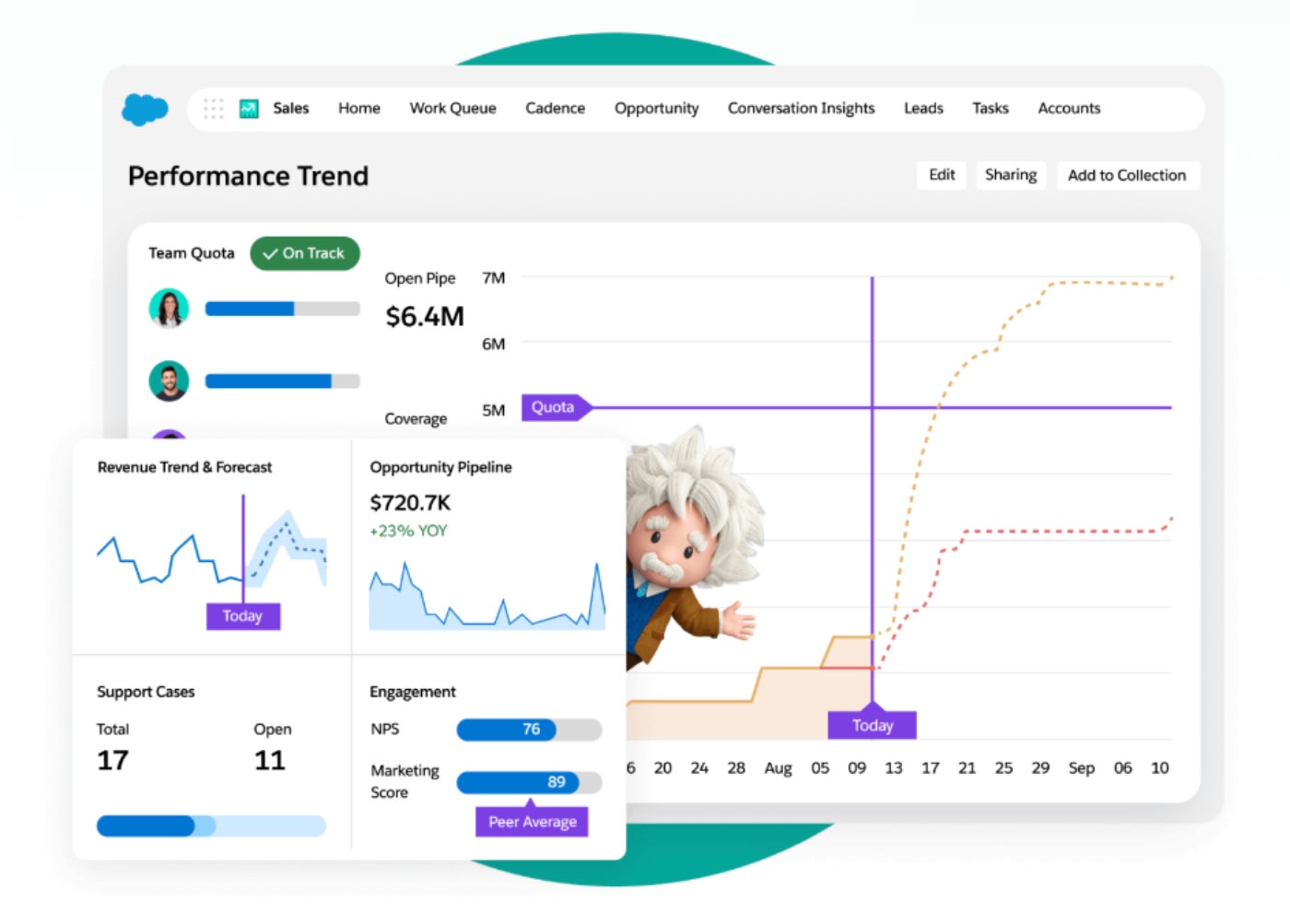
Salesforce pros and cons
| Pros | Cons |
|---|---|
| Lengthy free trial of 30 days. | Can be a costly option for small businesses. |
| Advanced AI and automation features. | Doesn’t offer a limited free version of the software. |
| Platform can be scaled to match needs of any business size. | Users report a steep learning curve. |
Why we chose Salesforce
Salesforce is a cloud-based platform that combines trusted AI and data to power sales and marketing teams. It offers customized industry solutions for a variety of business types such as automotive, communications, education, financial services and more. While its premium tiers are pricey compared to others on this list, Salesforce markets itself as a tool for small businesses just as much as enterprises.
Salesforce is a CRM designed with many powerful features. Because of this, some users with limited resources or expertise on CRM tools might find it over-complicated or hard to set up. Pipedrive’s affordability and 24/7 support on all plans might be more attractive to a startup.
To learn more about this provider, head over to our Salesforce review.
HubSpot: Best free alternative with core CRM features

HubSpot is popular CRM software that can be implemented by sales teams, marketers, customer service teams and operation managers. Its free CRM tool makes it a standout provider with access for up to 2,500 users, which is drastically above the industry average of two to five users for free plans. Its free tier also offers more core CRM features than others, such as meeting scheduler, email templates, company insights and reporting dashboards. This makes it an affordable and feature-rich alternative.
Pricing
- Free CRM: Free for up to 2,500 users with contact management, quotes, live chat and more.
- Sales Hub Starter: $15 per seat per month, billed annually, or $20 when billed monthly. The Starter plan includes all free tools, plus simple automation, e-signature, conversation routing and more.
- Sales Hub Professional: $90 per seat per month, billed annually, or $100 when billed monthly, plus a one-time $1,500 onboarding fee. This plan includes all Starter features and prospecting workspace, playbooks, forecasting and more.
- Sales Hub Enterprise: $150 per seat per month, with an annual commitment and one-time $3,500 onboarding fee. Users of this plan receive all Professional tools, plus advanced permissions, predictive lead scoring, conversation intelligence and lead form routing.
Features
- AI email writer: Use AI to create effective sales outreach emails in a fraction of the time while boosting email marketing campaigns.
- Company insights: Populate current contacts with insightful company details from HubSpot’s own database of over 20 million businesses.
- Lead tracking: Create custom criteria to automatically score and prioritize leads while gaining full visibility into each and every lead’s journey with your business.
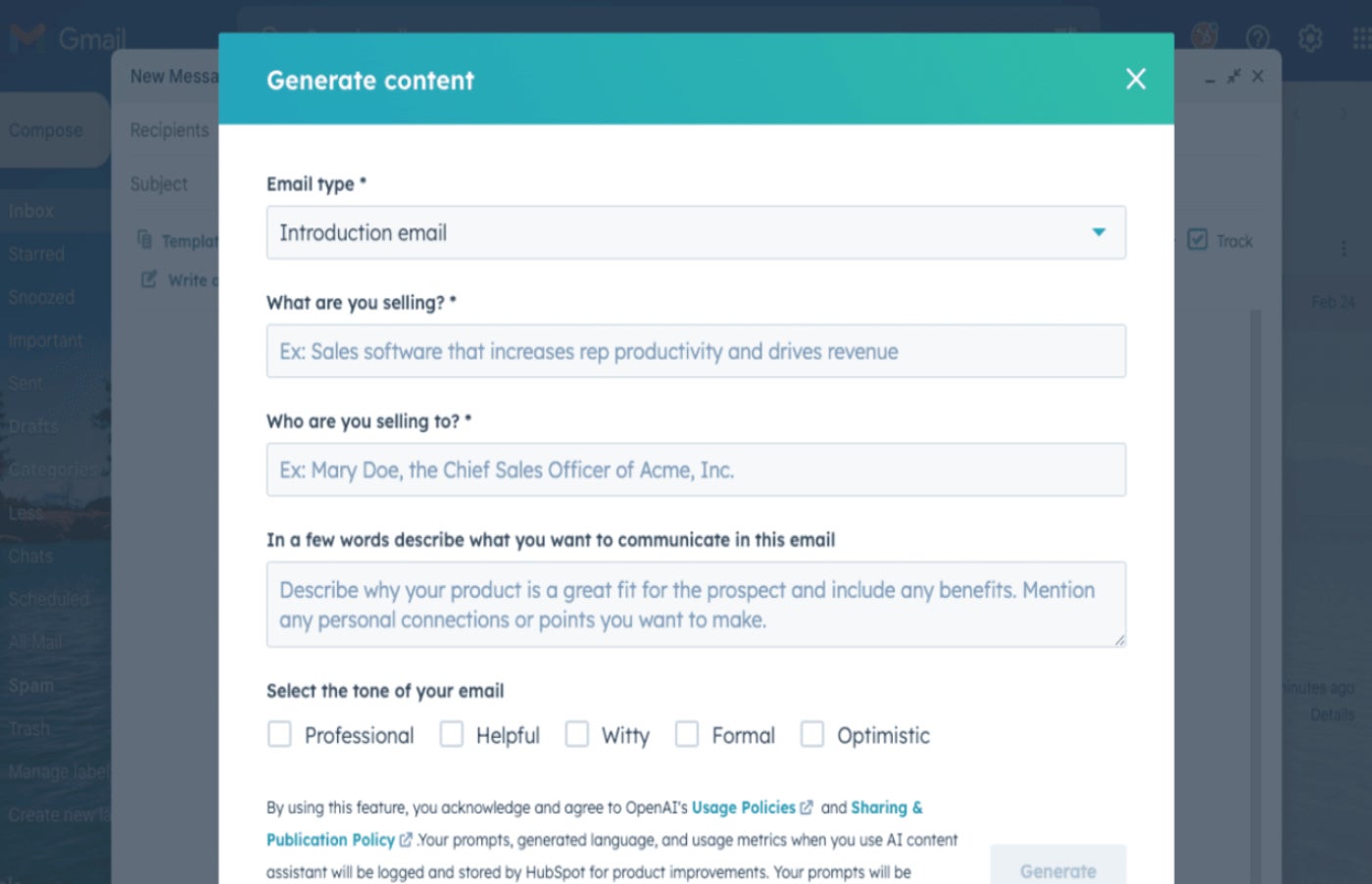
HubSpot pros and cons
| Pros | Cons |
|---|---|
| Offers discounts for qualified businesses like nonprofits and startups. | Doesn’t offer a free trial of the tool. |
| Users report easy and quick onboarding. | Free plan users can’t access live customer support. |
| Users report a simple and intuitive interface. | The higher premium tiers can be expensive with the additional add-ons. |
Why we chose HubSpot
HubSpot’s all-in-one platform offers tools for managing sales, marketing and customer service processes. Its free CRM and custom pipeline builder make it easy to scale up or down to fit any organization’s sales and customer management needs. While its premium tiers are more expensive, they’re catering more to larger businesses that have an allocated budget.
HubSpot offers more third-party integrations than Pipedrive. And while Pipedrive helps with simple automations and workflows, HubSpot allows for unique automations throughout a business’ sales process. Read our full comparison of HubSpot vs. Pipedrive for even more information on how these two providers stack up against each other.
Head over to our independent HubSpot review for more.
Features
- Omnichannel communication: Connect with customers through multiple channels such as social media, live chat, email, webforms and events, all while keeping information centralized.
- AI-powered assistant: Utilize Zia, the conversational sales assistant that can gather information, take notes, predict sales outcomes and automate repetitive tasks.
- Journey orchestration: Create complex and cross-functional paths that define what happens at various stages of your customer journey, which personalizes their experience with your business.

Zoho CRM pros and cons
| Pros | Cons |
|---|---|
| 15-day free trial. | Only offers 8/5 customer support. |
| Advanced sales and marketing tools. | Users report limited platform tutorials and community user resources. |
| Offers robust social media integrations such as LinkedIn, Meta and more. | Free CRM tier doesn’t offer social integrations. |
Why we chose Zoho CRM
Zoho CRM is a popular CRM for how it assists customer-facing teams with robust automations, digestible analytics and personalized solutions. With over 800 apps for possible integration, the tool can be quickly integrated into an organization’s current sales process and tech stack. Its AI features are also advanced compared to others on this list if businesses can afford the higher two pricing tiers.
Compared to Pipedrive, Zoho CRM offers a fair mix of features for the cost. Zoho CRM’s free tier is also a standout offering since Pipedrive doesn’t have one. Zoho CRM’s modern CRM interface and hyperfocus on industry-specific solutions make it a very flexible tool for just about any business.
For more details, read our Zoho CRM review.
monday sales CRM: Best for managing projects with kanban boards

The sales dashboard provided by monday sales CRM can keep track of deal pipelines, targets and team performance. Users can understand task progress at a glance, making it easy to identify and prevent inefficiency. The kanban pipelines utilize drag-and-drop tools that make the view entirely customizable with intuitive color-coding. This view allows users to manage all communication and workflows in one place through smart sorting and filtering.
Pricing
- Basic CRM: $12 per user per month, billed annually, or $15 when billed monthly. This tier offers unlimited pipelines, boards and contacts, as well as templates for lead, contact and deal management.
- Standard CRM: $17 per user per month, billed annually, or $20 when billed monthly. This includes advanced account, contact and deal management, two-way email integration with Gmail and Outlook, and an AI email generator.
- Pro CRM: $28 per user per month, billed annually, or $33 when billed monthly. This tier includes sales forecasting, email templates with custom parameters, mass emails and added integrations.
- Enterprise CRM: Contact monday.com for a quote. This tier offers lead scoring, team goals and advanced analytics.
Features
- Data importing: Import all existing leads, contacts and accounts from Excel through an API directly into monday and merge any duplicate data.
- Activity tracking: Access past emails or any sales activity with a client from anywhere with the monday sales CRM mobile app.
- Sales forecasting: Leverage real-time reports to track forecasted deals vs. actual sales.
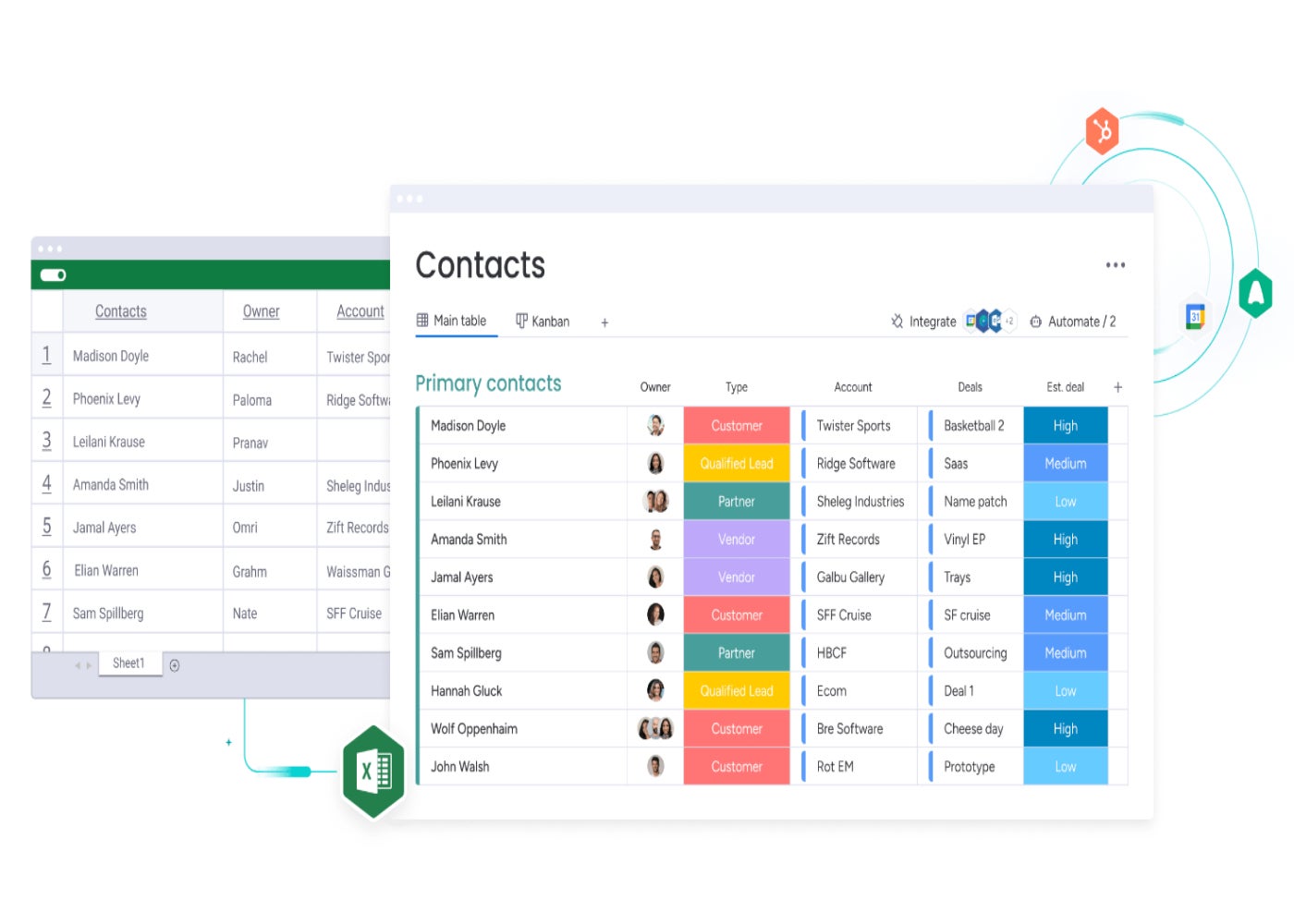
monday sales CRM pros and cons
| Pros | Cons |
|---|---|
| 14-day free trial. | Lead scoring is only available in the highest-paid tier. |
| Offers unlimited contacts with every subscription. | HIPAA compliance is only available for the highest-paid tier. |
| Provides advanced collaboration tools for team members. | Doesn’t provide a scaled back version of the tool for free. |
Why we chose monday sales CRM
monday.com is a powerful project management and collaboration platform. Its monday sales CRM software offers good basic features for startups and small businesses. monday sales CRM also offers unlimited user permissions and is SOC 2-compliant with AES-256 encryption, providing needed privacy and security for data.
Both Pipedrive and monday sales CRM offer similar pipeline tracking interface and mobile apps for iOS and Android. monday sales CRM’s AI-powered tools are all still currently in a beta phase and are only available through a paid add-on. Overall, monday sales CRM pricing plans are slightly lower than Pipedrive’s, but that doesn’t include any add-on features businesses might require.
Check out our monday sales CRM review for more about this provider.
Copper: Best for integrating with Google Workspace
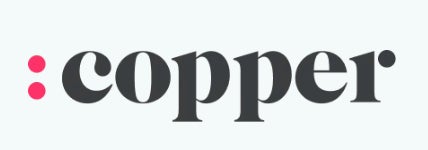
Copper’s CRM integration with the entire Google Workspace means users don’t need to switch tabs to add leads, track email conversations, find files and manage tasks. Businesses can streamline contact management efforts by adding new contacts directly from Gmail and Calendar. Files and Google Docs sync to Copper contact records automatically from the Drive.
Pricing
- Basic: $23 per user per month, billed annually, or $29 per user per month, billed monthly. This plan supports up to 2,500 contacts, task automation, email templates and customizable pipelines.
- Professional: $59 per user per month, billed annually, or $69 per user per month, billed monthly. The Professional plan offers all Basic features, plus bulk emails, sales automations, reporting templates library and more.
- Business: $99 per user per month, billed annually, or $134 per user per month, billed monthly. This tier comes with all mentioned features, plus lead scoring, email scheduling and social media integrations.
Features
- Reporting templates: Run new reports with just a few clicks with prebuilt templates.
- Contact management: Tag, filter and sort all leads, contacts and clients by any criteria. Then save those lists by contact type for future searches.
- Email drip campaigns: Save time by creating drip campaigns that engage with leads through automated emails sent in a nurturing sequence.
Figure E: Copper reporting templates dashboard. Image: Copper
Copper pros and cons
| Pros | Cons |
|---|---|
| 14-day free trial. | Basic tier only integrates with Zapier. |
| Seamless integrations with Google Workspace. | Not scalable for larger enterprises. |
| Offers in-person training, webinars, live online support and video resources for users. | Users report some complications when onboarding and implementing the tool. |
Why we chose Copper
Copper is a CRM solution targeted at small to mid-sized businesses. It integrates well with Google, but it’s not the most affordable option on this list. While many of its basic features are only unlimited on higher-tier plans, users do praise its clean interface and native marketing tools.
Pipedrive offers unlimited user limits on all plans, while Copper limits the number of users on its Basic plan. Also, Pipedrive can bill companies in different currencies, including USD, EUR and GBP, and Copper only supports USD. This makes Pipedrive a standout choice for larger international companies looking for a CRM solution.
Do you need an alternative to Pipedrive?
Pipedrive is a well-rounded CRM that can give a small to mid-sized business all the tools they need for effective deal management. Since the CRM software market can offer broad-solutions just as much as niche industry-specific solutions, it’s worth understanding where Pipedrive might fall short before committing to an annual subscription. So if you’re an enterprise-sized organization with a large amount of contacts, data and users to consider when selecting a provider, there are other providers to consider first.
Pipedrive’s largest disadvantage compared to its most popular alternatives is that there isn’t a free version of its tool available, even with a capped number of users. Free CRM software has been rising in popularity for their obvious affordability and limited access to certain core features. They offer the potential for unique add-ons and scalability to a premium subscription only when needed.
Depending on the needs, resources and knowledge base of your business, Pipedrive’s straightforwardness and minimalist UX/UI might be a restraint. If your business has the bandwidth to consider an open-source CRM instead, there can be benefits from additional customization. This won’t be the case for everyone, but the benefits of cost effectiveness, customizations and quick improvements or bug fixes are worth looking into.
Review methodology
Each alternative provider I mentioned above was scored against a rubric with outlined criteria and subcategories of CRM industry standards. I used that rubric and an in-house algorithm to calculate an overall star rating. Those ratings and the ideal use cases I assign to each alternative are then compared to Pipedrive’s offerings to identify any gaps in capabilities.
Here is a breakdown of the scoring criteria I followed:
- Cost: Weighted 25% of the total score.
- Core features: Weighted 25% of the total score.
- Customizations: Weighted 15% of the total score.
- Integrations: Weighted 15% of the total score.
- Ease of use: Weighted 10% of the total score.
- Customer support: Weighted 10% of the total score.
Source of Article



